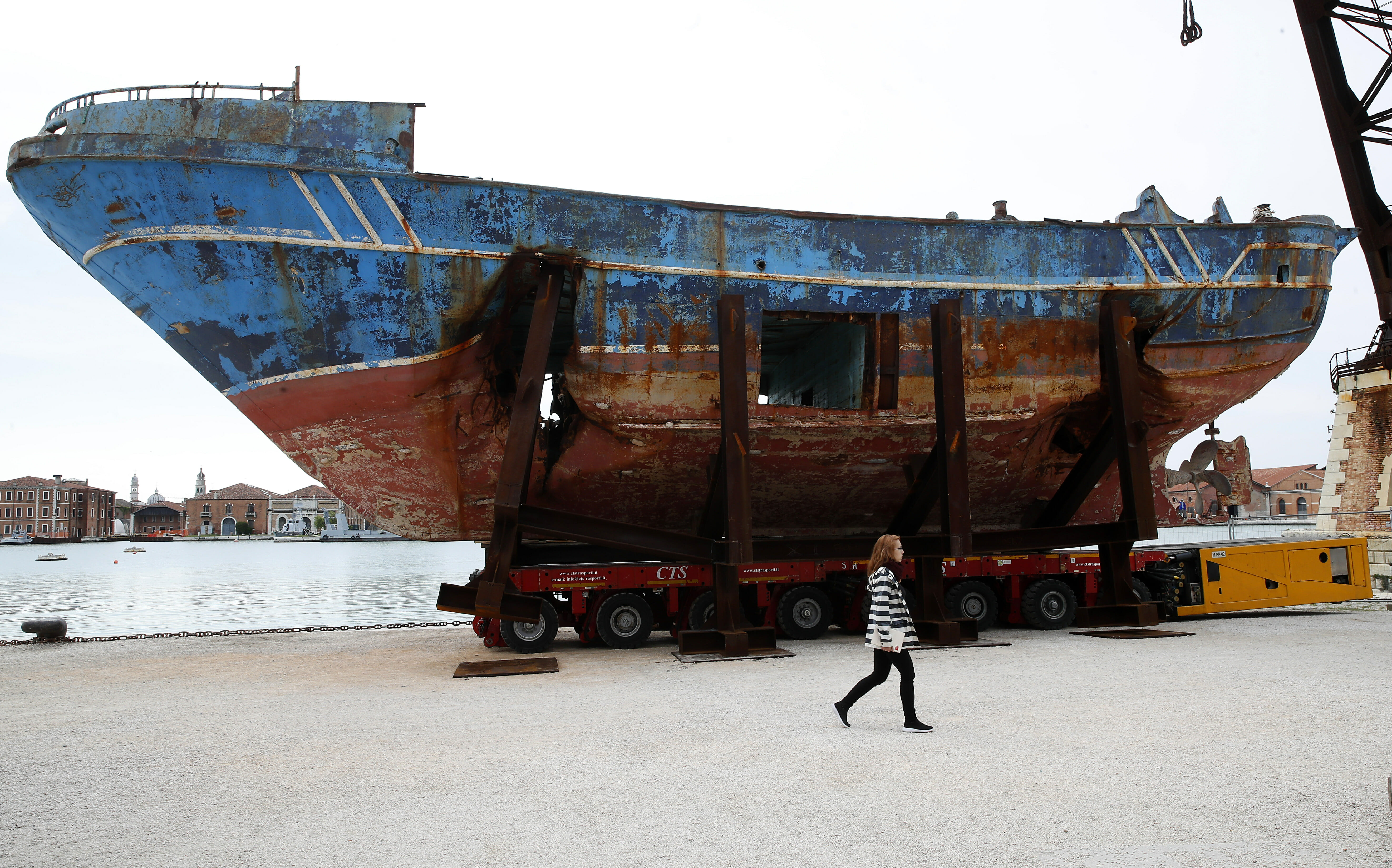
Venice Biennale invites heavy thinking on political issues
VENICE, Italy (AP) — Fake news. Migration. Poverty. Global warming. Armed conflict.
Political issues that excite newsprint, the airwaves and social media are getting a very open airing at the 58th Venice Biennale contemporary art fair, like so much laundry hung out to dry in the lagoon breeze.
American curator Ralph Rugoff, director of London’s Hayward Gallery, titled the main exhibition “May You Live in Interesting Times,” which opens Saturday and runs through Nov. 24. The title is itself an exemplary piece of fake news, delivered by a British lawmaker as Europe hurled toward World War II as an ancient Chinese curse.
It was, in fact, made up. Yet, Rugoff notes, “it’s had a presence in political discourse ever since.”
Rugoff says contemporary art is particularly effective at unpacking the present-day specter of never-ending crises, by revealing complexity, ambiguity and conflicting emotions in a way more traditional media often do not.
“Where do we have a space in our culture where this part of being human is given a place? It really exists in contemporary art,” Rugoff said this week on a preview walk through the two-part main exhibit, split between the Biennale’s two main venues, in the leafy Giardini and the former Arsenale shipyard.
Many of the 79 artists invited to participate in the main exhibition make very literal references to present-day woes.
Swiss artist Christoph Buechel transported a hulking smugglers’ ship where 700 migrants perished in April 2015 to the edge of the Arsenale, exposing to viewers the gaping holes in the hull that caused it to sink in the Mediterranean. Chinese collabators Sun Yuan and Peng Yu constructed a robot that mechanically spreads a blood-like substance evenly around. The impact of drug violence is portrayed in Teresa Margolles’ razor-wire topped concrete wall “Muro Ciudad Juarez.”
Zhanna Kadyrova of Ukraine used old tiles to create pieces of laundry that are hung outside the central pavilion, which Rugoff says serves as a reminder that while inside the building “there is a lot of heavy thinking and challenging art,” ordinary life continues just outside, in the narrow Venetian alleyways where everyday flapping laundry is show of its own.
By juxtaposing art in its many forms that provide comments on worldly events, Rugoff wants to create conversations, and the Giardini Central Pavilion emits a vapor suggestive in a very literal way of thought processes, which in turn casts a veil of fog over the pavilion’s facade, “questioning the authority of that institution.”
In a Biennale that puts a real emphasis on the interactive experience of art, mist has emerged a major artistic medium across the sprawling exhibition, which extends beyond the main exhibition into 90 national pavilions and manifold collateral events.
Israeli artist Aya Ben Ron has created a field hospital to treat social ills from domestic abuse to racism to occupation, which forces hurried visitors to slow down, take and number and wait their turn. Australian artist Angelica Mesiti uses film to examine ways citizens can assemble and communicate against the backdrop of fragile democracy. And American Martin Puryeare explores liberty through a series of clear, declarative sculptures and installations that are a rebuke against racism and testosterone-drive power.
Beyond the Biennale, Marina Abramovic asks whether empathy created in a virtual reality experience can motivate action against climate change.
The French pavilion also emits vapor, meant to create a dreamlike environment for the journey proposed by 41-year-old artist Laure Prouvost, only the third woman to represent France at the Biennale.
Hers is an immersive experience of film, performance and installations featuring, among other details, two living white seabirds pecking along a neglected seaside where Murano glass shoes representing humanity’s castoffs lie alongside colorful sea life, representing the artist’s concern about climate change and ecology, according to curator Martha Kirszenbaum.
Mist is put to effective use inside the Indian Pavilion, which is a thematic tribute to Mahatma Gandhi, marking the 150th anniversary of his birth. Artist Jitish Kallat projects a 1939 letter written by Gandhi to Adolf Hitler, appealing to him to prevent war and addressing him as “friend.” The audience can not only read the letter, but walk through the projection and be literally illuminated by its message.
Kallat said the “Dear friend” salutation projects Gandhi’s message across time “and asks the reader to rethink what they … can do to save the world from going to a savage state.”
Ghana also is making its Biennale debut, one of only six African nations participating. The pavilion was designed by architect David Adjaye as a series of interconnected units that form a whole, recalling West African dwellings, while the late Okwui Enwezor, the 2015 Biennale curator who died in March, served as an adviser. It features all newly commissioned works, from sculpture, to film and photography, which will travel to Ghana after the Biennale for show.
“Things like this, I guess, is a form of self-politics. It is a way of representing your culture in a way other than political and economic,” said curator Nana Oforiatta Ayim.
“We have so many pluralistic expressions, so many ways of being in Ghana, but often so often in the outside world, you just get one, and very often it is negative. This is very much how we represent ourselves to the world in all our plurality, in all our diversity, in all our different layers.”
The Western Journal has not reviewed this Associated Press story prior to publication. Therefore, it may contain editorial bias or may in some other way not meet our normal editorial standards. It is provided to our readers as a service from The Western Journal.
Truth and Accuracy
We are committed to truth and accuracy in all of our journalism. Read our editorial standards.
Advertise with The Western Journal and reach millions of highly engaged readers, while supporting our work. Advertise Today.












